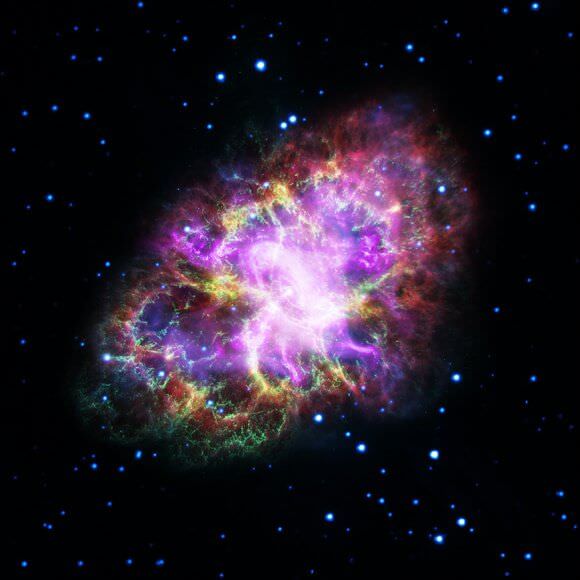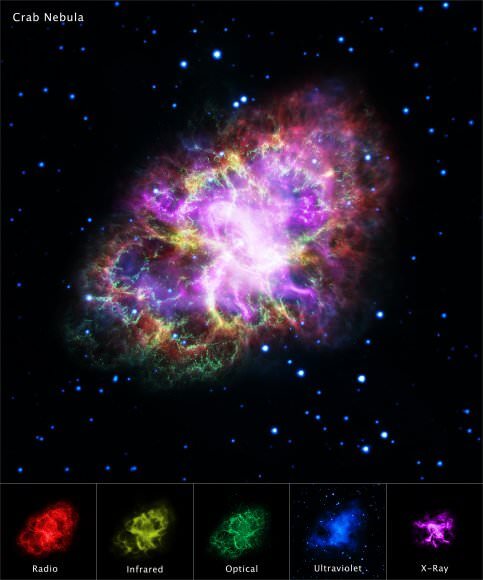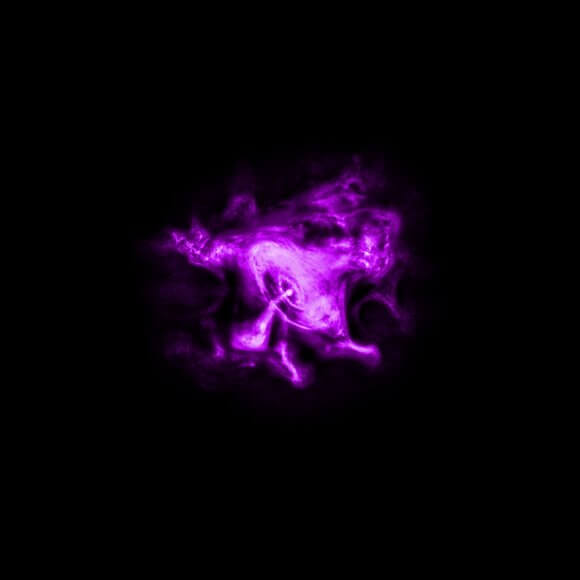Stunning View of the Crab Nebula Just Got Five Times Better

Images of the Crab Nebula are always a treat because of it has such intriguing and varied structure. Also, just knowing that this stellar explosion was witnessed and recorded by people on Earth more than 900 years ago (with the supernova visible to the naked eye for about two years) gives this nebula added fascination.
A new image just might be the biggest Crab Nebula treat ever, as five different observatories combined forces to create an incredibly detailed view, with stunning details of the nebula’s interior region.
Data from telescopes spanning nearly the entire breadth of the electromagnetic spectrum, from radio waves seen by the Karl G. Jansky Very Large Array (VLA) to the powerful X-ray glow as seen by the orbiting Chandra X-ray Observatory. And, in between that range of wavelengths, the Hubble Space Telescope’s crisp visible-light view, and the infrared perspective of the Spitzer Space Telescope.

Astronomers have produced a highly detailed image of the Crab Nebula, by combining data from telescopes spanning nearly the entire breadth of the electromagnetic spectrum. This image combines data from five different telescopes: the VLA (radio) in red; Spitzer Space Telescope (infrared) in yellow; Hubble Space Telescope (visible) in green; XMM-Newton (ultraviolet) in blue; and Chandra X-ray Observatory (X-ray) in purple. Credit: NASA, ESA, G. Dubner (IAFE, CONICET-University of Buenos Aires) et al.; A. Loll et al.; T. Temim et al.; F. Seward et al.; VLA/NRAO/AUI/NSF; Chandra/CXC; Spitzer/JPL-Caltech; XMM-Newton/ESA; and Hubble/STScI.
The Crab is 6,500 light-years from Earth and spans about 10 light-years in diameter. The supernova that created it was first witnessed in 1054 A. D. At its center is a super-dense neutron star that is as massive as the Sun but with only the size of a small town. This pulsar rotates every 33 milliseconds, shooting out spinning lighthouse-like beams of radio waves and light. The pulsar can be seen as the bright dot at the center of the image.
Scientists say the nebula’s intricate shape is caused by a complex interplay of the pulsar, a fast-moving wind of particles coming from the pulsar, and material originally ejected by the supernova explosion and by the star itself before the explosion.
For this new image, the VLA, Hubble, and Chandra observations all were made at nearly the same time in November of 2012. A team of scientists led by Gloria Dubner of the Institute of Astronomy and Physics (IAFE), the National Council of Scientific Research (CONICET), and the University of Buenos Aires in Argentina then made a thorough analysis of the newly revealed details in a quest to gain new insights into the complex physics of the object. They are reporting their findings in the Astrophysical Journal (see the pre-print here).
About the central region, the team writes, “The new HST NIR [near infrared] image of the central region shows the well-known elliptical torus around the pulsar, composed of a series of concentric narrow features of variable intensity and width… The comparison of the radio and the X-ray emission distributions in the central region suggests the existence of a double-jet system from the pulsar, one detected in X-rays and the other in radio. None of them starts at the pulsar itself but in its environs.”
“Comparing these new images, made at different wavelengths, is providing us with a wealth of new detail about the Crab Nebula. Though the Crab has been studied extensively for years, we still have much to learn about it,” Dubner said.

A multi-wavelength layout of the Crab Nebula. Credit: (Credit: X-ray: NASA/CXC/SAO; Optical: NASA/STScI; Infrared: NASA/JPL/Caltech; Radio: NSF/NRAO/VLA; Ultraviolet: ESA/XMM-Newton).
Read the team’s paper: Morphological properties of the Crab Nebula: a detailed multiwavelength study based on new VLA, HST, Chandra and XMM-Newton images
Sources: Chandra, Hubble
The post Stunning View of the Crab Nebula Just Got Five Times Better appeared first on Universe Today.
Universe Today
Go to Source
Powered by WPeMatico
